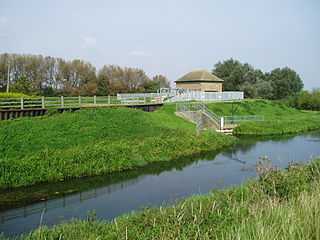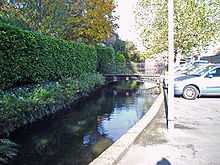Bourne Eau

Bourne Eau is a short river which rises in the town of Bourne in Lincolnshire, England, and flows in an easterly direction to join the River Glen at Tongue End. It is an embanked river, as its normal level is higher than that of the surrounding Fens. It was navigable in the 18th and 19th century, but now forms an important part of the drainage system that enables the surrounding fen land to be used for agriculture.
Course

Bourne Eau rises in The Wellhead, otherwise known as St Peter's Pool, in Bourne, Lincolnshire.[1] The Wellhead is a natural artesian spring which once formed the source of the water defences of Bourne Castle as well as the power for the town's three mills.[1] On entering Bourne North Fen it follows an artificial course which it was given, probably, in the first half of the thirteenth century when the south Lincolnshire Fens ceased to be a Royal forest. Hitherto, it had occupied the channel known as the Old Ea which was of Roman date, most likely second century.[citation needed] The present course enters the River Glen at Tongue End, a name which derives from the low tongue of land within the enclosing banks of the rivers.
Apart from the spring, most of the water of the river is collected by the Car Dyke, which, near Bourne, is arranged to act as a catchwater drain, gathering the surface water of the upland and feeding it via the Bourne Eau and River Glen to the sea, without its entering The Fens.
History

From 1765, the north bank of the river was the responsibility of the Black Sluice Commissioners, a body which had been created by an Act of Parliament, to construct the Black Sluice where the South Forty-Foot Drain entered The Haven at Boston, and to supervise the drainage of the Fens feeding that system. The north bank was a serious problem, as it was built on a peat subsoil, and defied attempts to raise it, with the result that the Bourne Fens often flooded.[2] Improvements to the 3.5 miles (5.6 km) of river from the River Glen junction to the town of Bourne were authorised by an act of Parliament obtained on 29 March 1781, which suggested that the river had previously been navigable, but had become choked with mud. The act created a body of 12 trustees, who were empowered to maintain a channel which was 30 feet (9.1 m) wide by 5 feet (1.5 m) deep.[3] The navigation included two locks, one near the junction with the Glen, and the other near Bourne.[1]
In order to ease the problems caused by the north bank, the Black Sluice Commissioners negotiated with the Trustees to allow them to build a set of flood gates at Tongue End, where the river joined the Glen, and an overfall weir, which allowed surplus water to flow over the bank and into the Weir Dyke in Bourne Fen.[2] The self-acting doors were replaced by a sluice in the 1860s, which effectively brought navigation to an end,[1] and the sluice was replaced by a pumping station in 1966, which removed the need for the overfall weir.[2]
Linguistic derivations
The use of the French-seeming Eau as the name of a Fenland river is not unique. It appears to have arisen in the eighteenth century. The earlier term was Ea, which arises from an Anglo-Danish word for river. Compare the Danish aa, nowadays written å. This Danish, one-letter word is pronounced as a French o but shortened by a glottal stop or as a curt English aw as a pure vowel rather than a diphthong. The eighteenth century engineers and map-makers seem to have been more familiar with French than with Danish. However, in the German-speaking parts of Schleswig-Holstein, rivers which across the border in Denmark, fit this nomenclature are called Au,[4] which is not widely different from the English pronunciation of Eau.
The following is extracted from the Wikipedia article on Aachen. "The Romans named the hot sulphur springs there, Aquis-Granum. For the origin of the Granus several theories were developed, but it is now widely accepted that it derives from the Celtic god of water and health. The hot springs have been channelled into baths since Roman times, and these are still in use. The element ‘’âh’’- is an Old German cognate with Latin ‘’aqua’’, both meaning "water". In French-speaking areas of the former Empire the word ‘’aquas’’ was turned into ‘’aix’’, hence Aix-en-Provence is an old Roman spa in Provence." Thus, the use of the French word for water, eau is not after all, so inappropriate.
A bourne is a stream flowing from a spring. Thus, although the town in which it rises is called Bourne and this apparently gives rise to the river's name, the Bourne Eau is clearly the bourne in question. Bourne is the southern English cognate of the burn of northern English. However, in later use, each has begun to lose its association with the spring, burn the more so.
Wheeler gives the name Bourne Old Ea to what is now the Bourne Eau and Bourne Ea or Brunne Ea to that part of the Glen downstream of Kate's Bridge. He then quotes Dugdale, and an act of Queen Elizabeth I:
- Brunne, River of, Brunne Hee,Burne Alde Ee. In Dugdale the Brunne Ee is describhed in the margin as 'now the Glene'...'Which had its course through the midst of the town of Pincbec.' The 'Ware' Dyke is described as extending along 'the river of Burne Ee to Godramscote' in a commission of Sewers held at Hempringingham in Queen Elisabeth's time.
[5]
See also
- Aa River
- Bourne-Morton Canal
References
- ↑ 1.0 1.1 1.2 1.3 "Bourne Eau History". East Anglian Waterways Association.
- ↑ 2.0 2.1 2.2 "History of the Draining of the Fens in the Black Sluice Area". The Black Sluice Internal Drainage Board. Retrieved 19 December 2010.
- ↑ Joseph Priestley, (1831), Historical Account of the Navigable Rivers, Canals, and Railways, of Great Britain
- ↑ File:Provinz Schleswig-Holstein 1905.png
- ↑ Wheeler M.Inst.C.E, William Henry (1896). A History of the Fens of South Lincolnshire, being a description of the rivers Witham and Welland and their estuary, and an account of the Reclamation, Drainage, and Enclosure of the fens adjacent thereto. (2nd ed.). J.M. Newcombe (Boston), Simpkin, Marshall & Co. (London). p. Appendix 1, p 7. doi:10.1680/ahotfosl2e.50358.
External links
Coordinates: 52°45′56″N 0°22′54″W / 52.76565°N 0.38153°W
| |||||